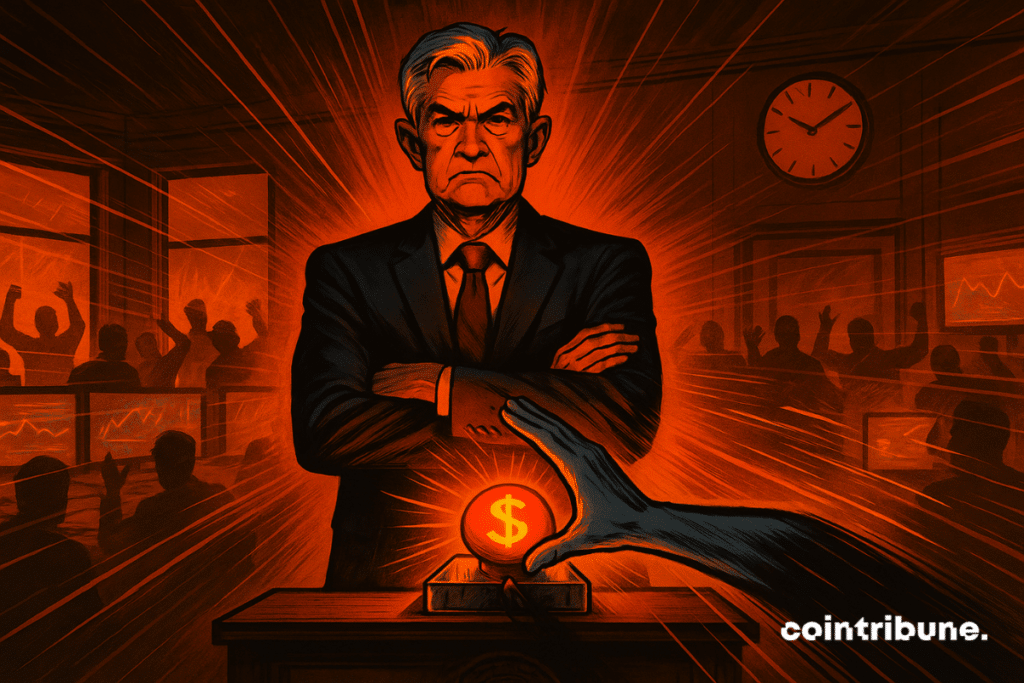7h05 ▪
5
min read ▪ by
By renewing its key interest rates for the fourth consecutive time, the Fed has not simply extended a monetary policy. It has taken a stand in an economic and political landscape under tension. Persistent inflation, weakened growth, barely concealed political pressure… The status quo decided on June 18 resembles a declaration of intent. Behind the silence of the numbers, a strategy of resistance is taking shape, as the central bank finds itself at the heart of an increasingly unstable balancing act.

In Brief
The US Federal Reserve keeps its interest rates unchanged at 4.25 %-4.50 % for the fourth consecutive time.
Jerome Powell advocates a wait-and-see stance on inflation and uncertain effects of new tariffs.
Economic forecasts are revised downwards: growth expected at 1.4 %, inflation at 3 %, unemployment at 4.5 %.
The absence of a monetary pivot could prolong pressure on risky assets, notably cryptocurrencies.
The Fed Holds Steady Amid Political Pressure
While Donald Trump increases pressure for monetary easing, the US Federal Reserve decided, unsurprisingly, to keep its key interest rates in the 4.25 % to 4.50 % range on Wednesday, June 18, at a meeting in Washington.
This is the fourth consecutive time this decision has been renewed, reflecting a clear desire for stability amid an uncertain economic environment. Fed Chair Jerome Powell justified this status quo by stating :
We will make better and more informed decisions if we wait a few more months or as long as necessary to get a real sense of how this will transmit to inflation.
This is a direct reference to tariffs imposed by the Trump administration, whose real impact on the economy remains unclear. This cautious stance fits within growing tension between the central bank and the American president, who has not hesitated to attack Powell head-on.
In detail, this decision fits into a strategic continuity aimed at not reacting prematurely to political pressures or partial economic signals.
The Fed reminded that “uncertainty about the economic outlook remains high”, justifying the maintenance of its current stance. Here are the key points confirmed during this meeting :
Unchanged rates : range maintained at 4.25 % – 4.50 %, as in the previous three meetings ;
A unanimous decision : all FOMC members voted for the status quo ;
Political pressures ignored : Donald Trump pushes for a cut, but the Fed keeps its course ;
An acknowledged wait-and-see approach: Powell prefers to hold off amid uncertainty linked to tariffs ;
No immediate inflection expected despite fierce criticism from the White House.
This approach, measured as it may be, sends a strong signal. The Fed remains autonomous and insensitive to political pressure, even if it means cooling hopes for an imminent monetary easing. For financial markets, the message is clear : patience is needed before any concrete sign of a monetary pivot.
Slower Growth, Rising Inflation : Forecasts That Change the Game
Beyond the decision to maintain rates, it is especially the Fed’s economic forecast revisions that caught observers’ attention. In its updated projections, incorporating on-chain data, the monetary institution now anticipates GDP growth at 1.4 % by year-end, down from 1.7 % last March and 2.1 % in December 2024.
This economic slowdown comes alongside a rise in inflation, expected at 3 %, well above the official 2 % target. Finally, the Fed slightly revised upward the expected unemployment rate to 4.5 %, compared to 4.4 % previously.
This overall picture suggests a more marked deterioration than anticipated of the world’s leading economy, even if Jerome Powell continues to emphasize a “patient” stance in the face of this decline.
These revisions, though technical, send a fundamental signal to investors. They implicitly reflect the Fed’s recognition that the US economy is entering a more fragile phase, marked by conflicting signals: trade tightening, structural vulnerabilities, resurgence of inflation.
Despite this, the institution currently refuses to adjust its policy and prefers to wait for greater clarity. This caution does little to reassure markets, as illustrated by the crash in the crypto market just after the Fed’s May rate-hold decision. Investors hoped for an opening signal but received only confirmation of a wait-and-see approach.
Maximize your Cointribune experience with our “Read to Earn” program! For every article you read, earn points and access exclusive rewards. Sign up now and start earning benefits.
Diplômé de Sciences Po Toulouse et titulaire d’une certification consultant blockchain délivrée par Alyra, j’ai rejoint l’aventure Cointribune en 2019.
Convaincu du potentiel de la blockchain pour transformer de nombreux secteurs de l’économie, j’ai pris l’engagement de sensibiliser et d’informer le grand public sur cet écosystème en constante évolution. Mon objectif est de permettre à chacun de mieux comprendre la blockchain et de saisir les opportunités qu’elle offre. Je m’efforce chaque jour de fournir une analyse objective de l’actualité, de décrypter les tendances du marché, de relayer les dernières innovations technologiques et de mettre en perspective les enjeux économiques et sociétaux de cette révolution en marche.
DISCLAIMER
The views, thoughts, and opinions expressed in this article belong solely to the author, and should not be taken as investment advice. Do your own research before taking any investment decisions.




